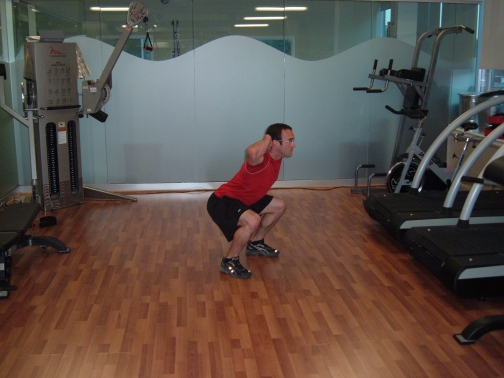Turbulence Training Questions
 Continuing on from yesterday, I’m going to answer some of the most popular Turbulence Training questions.
Continuing on from yesterday, I’m going to answer some of the most popular Turbulence Training questions.
What exactly is Turbulence Training?
Answer:
Turbulence Training is the combination of strength training and interval training – high-intensity exercise. Most people do not exercise at sufficient intensities to make the changes in their bodies that they want to make.
Yes, I know that running for 30 minutes straight is hard, it takes effort. But it is not as intense as running at a pace that can be maintained for only 1 minute.
High intensity exercise is more effective for changes in body composition than low-intensity exercise.
A recent study from Australia showed that short intervals were more effective for weight loss than a program of 40 minutes of cardio. Each workout was done 3 times per week. The interval training group trounced the slow-cardio group in weight loss. And this study was done in women!
Strength training, by its nature, is intense – more intense than slow cardio. And it too can be manipulated to increase your metabolic rate.
Why is it called Turbulence Training?
Answer:
Turbulence is the stimulus applied in training. Like an airplane that has to deal with turbulence in the air, a body exposed to turbulence in training will have to burn more fuel (i.e. calories) to return to normal after training.
If you use traditional methods of low-intensity cardio, your body is not taken outside of its comfort zone. No intensity, no turbulence, and you won’t get much of a result for all that time you put in the gym.
What is the best rep range to stick with if your goal is fat loss?
Answer:
For strength training, research has shown that 8 repetition sets increase post-exercise metabolism to a greater extent than 12 reps per set. And this was shown in women as well. Women can use Turbulence Training and other high-intensity methods just as effectively as men.
But really, the fat loss will come from these factors in this order:
1) Nutrition
2) Interval training
3) Resistance training
The strength training is essential for bodysculpting, building muscle, and maintaining muscle, and for the post-exercise boost in metabolism you get after strength training.
If people don’t have enough time to get to the gym what are some exercises they can do around the house?
Answer:
Oh man, I could go on for days here…
There are all kinds of squats, lunges, split squats, bodyweight rows, pushups, and ab exercises that can be done at home.
I like exercises that train multiple hot zones of the body at once. I have 4 hot zones I aim for: upper back, chest, abs, back of the legs. Train those areas and you’ll cover everything else indirectly.
So usually I start with a Y-squat (describe). Then a pushup variation. Those 2 exercises can be your basic warmup. Heres how they hit the 4 hot zones.
Then a real workout from these 4 hot zone exercises:
Split Squat FFE
Decline Pushup
Bodyweight Row
Mountain Climber
Bodyweight training is a combo of strength and interval training. Some bw can be pure strength however, while others can be pure interval. Others are just in-between.
What is “afterburn” and what are the best ways to activate it?
Answer:
Afterburn is what happens as a result of the turbulence applied in your training. Afterburn is the additional calories you burn after your workout – the increase in metabolism – you only get if the workout was of sufficient intensity.
Generally, slow, boring cardio workouts have little afterburn, whereas with strength training and interval training you have a lot of afterburn…b/c you have a lot of turbulence. So you burn some calories in the actual session of aerobic training, but not much in the 24-36 hours after.
On the other hand, with TT, you burn almost as many calories in the training session as with cardio, but then you continue to burn a lot more in the upcoming 24-36 hours. I’ve seen estimates of 500-700 extra calories. That’s significant. It’s like doing 2-3 workouts with TT vs. only 1 with aerobic training. 
That’s just one of the reason Turbulence Training kicks butt,
Craig Ballantyne, CSCS, MS
Author, Turbulence Training